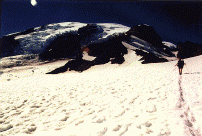 Two of my group members (Frank and Stuart), picked me up at the airport and
from there we
darted straight to the mountain, which was visible all throughout the
way. What a beautiful mountain, I though. A real gem.
Two of my group members (Frank and Stuart), picked me up at the airport and
from there we
darted straight to the mountain, which was visible all throughout the
way. What a beautiful mountain, I though. A real gem.
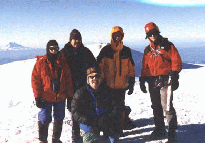 Sunday, July 27th 1997
Sunday, July 27th 1997It was the perfect ending, to a perfect weekend. I flew in from Boston on Thursday at mid-day. My flight was delayed in Newark for about 2 hours due to bad weather and yet, in Seattle, a city known for the ever presence of rain, the sun was shining like never before. Who would have guessed?
 Two of my group members (Frank and Stuart), picked me up at the airport and
from there we
darted straight to the mountain, which was visible all throughout the
way. What a beautiful mountain, I though. A real gem.
Two of my group members (Frank and Stuart), picked me up at the airport and
from there we
darted straight to the mountain, which was visible all throughout the
way. What a beautiful mountain, I though. A real gem.
We arrived at Paradise (the visitor center), around 4:30pm and quickly took care of the paper work (registration & permits). Unfortunately we were told that the walk-in camp ground had been closed and if we wanted to overnight in the park we'd have to go back down to another campground at about 3,000 ft. At first we were very reluctant to do this. As if going from 5,500 feet (the elevation of the parking lot), to over 10,000 feet (Camp Muir), in one day wasn't enough of an elevation gain, now they wanted us to spend the night even lower. Well, we had no other choice.
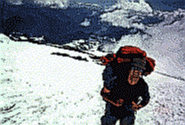 Friday, July 25th. 9:45am
Friday, July 25th. 9:45am
We start our hike to Camp Muir, at 10,000 feet. A long and strenous hike
for some of us. My pack must have weighted at least 60lbs. That's a lot
of gorp, I can tell you. It was an uneventful but long hike though. We
arrived at camp at the end of the day, around 5:30, exausted. I quickly
set up my tent, got some food, and soon after was ready to go to sleep.
The view from up here was incredible. A few miles down to the south lay
Mt.Adams and Mt. St. Helens. A few more miles south, I can see Oregon's
highest peak, Mt.Hood. The visibility was great and the setting sun
changed the color on these mountains from snow white to pink and then
to a fiery orange.
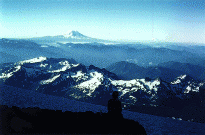 Saturday, July 26th, 12:30pm
Saturday, July 26th, 12:30pm
We arrive at the Hingrham flats, a fairly flat and safe snow field near the
top of Hingram Glacier. Today we were in no hurry. We hiked for only an
hour and a half, and an altitude gain of just a thousand feet. We've entered
the danger zone though. All traveling above Camp Muir is in glacier territory
and thus, all precausions typical of glacier travel are required. The five
of us traveled in two roped teams, the 3-person team (Frank, me and Barney)
leading the way, and Stuart and Peter following close behind. The
packs were lighter as we left one tent (mine) behind and were wearing some of
the heavier gear (crampons, harness, ropes, helmet and ice axe).
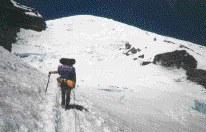 My arms were getting pretty toasty and my face was following the way, I
forgot my sunscreen.
In the afternoon we practiced some Crevase rescue techniques. This was
specially important to me because I had no experience at this, even though
I felt pretty comfortable with traveling in snow and ice. Being lowered
into a humongoes, crackling crevase was definately an experience never to
be missed and completely out of this world. The beast must have been close
to 100 feet deep. It could have been more. I couldn't see the end of it.
We went to bed early, the summit attempt started at mid-night.
My arms were getting pretty toasty and my face was following the way, I
forgot my sunscreen.
In the afternoon we practiced some Crevase rescue techniques. This was
specially important to me because I had no experience at this, even though
I felt pretty comfortable with traveling in snow and ice. Being lowered
into a humongoes, crackling crevase was definately an experience never to
be missed and completely out of this world. The beast must have been close
to 100 feet deep. It could have been more. I couldn't see the end of it.
We went to bed early, the summit attempt started at mid-night.
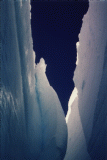 Sunday, July 27th, 0:30am
Sunday, July 27th, 0:30am
It was cold, my leather boots were hard and the laces were frozen. So were
most of my clothes but nothing could stop me now. We actually were up way
before the planned mid-night wake up call. We headed out even before 1am.
It was slow moving at first, as we adjusted to night travel and
worked our stiff bodies up the moderate slope and across the glacier.
Then things picked up a bit
and the terrain got steep. Really steep.
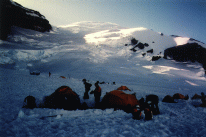 The night was bright and there was so many stars that I kept my headlamp
off for most of the time. As we climbed higher, the glacier down below
looked increasingly impressive. Behind us a long line of little bright
lights followed. Well over one hundred climbers must have summitted on
this day. We reached the top of the Cleaver and then, at about 13,000 feet
I hit the wall. I
didn't even see it coming. My legs started dragging and my breathing
became really difficult. I needed to stop more often than before. But
weird enough, it was gone almost as fast as it came. I felt pretty good
during the last 400 feet or so, and as unexpectedly as it can be, the rim
of the crater was right there, just a few steps further up.
The night was bright and there was so many stars that I kept my headlamp
off for most of the time. As we climbed higher, the glacier down below
looked increasingly impressive. Behind us a long line of little bright
lights followed. Well over one hundred climbers must have summitted on
this day. We reached the top of the Cleaver and then, at about 13,000 feet
I hit the wall. I
didn't even see it coming. My legs started dragging and my breathing
became really difficult. I needed to stop more often than before. But
weird enough, it was gone almost as fast as it came. I felt pretty good
during the last 400 feet or so, and as unexpectedly as it can be, the rim
of the crater was right there, just a few steps further up.
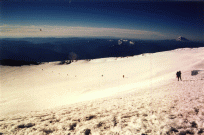 I almost missed that magical moment, characteristical of every sunrise
viewed from a snowcapped mountain top, while laboring my way up the steep
slope. But now
things were different. The view was astonishing. I was on top. I'd
made it past the optional part. The seemingly harder part was over but the
truth is, the descent was even harder. Not necessarily more tiring but
really hard on the legs and feet. Down climbing 9,000 feet in one day after
climbing 3,000 can put a hell of a burden on anybody's legs.
I almost missed that magical moment, characteristical of every sunrise
viewed from a snowcapped mountain top, while laboring my way up the steep
slope. But now
things were different. The view was astonishing. I was on top. I'd
made it past the optional part. The seemingly harder part was over but the
truth is, the descent was even harder. Not necessarily more tiring but
really hard on the legs and feet. Down climbing 9,000 feet in one day after
climbing 3,000 can put a hell of a burden on anybody's legs.
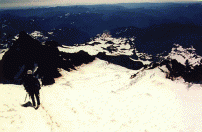 The sun was still incredibly bright by the time I reached the parking lot.
The guys had left Camp Muir more than half hour earlir while I packed
my tent that was left behind the day before, and by now the
beer was flowing. I just wanted lots of water and a shower. I'd run out
of water half way down the mountain and was feeling as dry as a raisin.
The sun was still incredibly bright by the time I reached the parking lot.
The guys had left Camp Muir more than half hour earlir while I packed
my tent that was left behind the day before, and by now the
beer was flowing. I just wanted lots of water and a shower. I'd run out
of water half way down the mountain and was feeling as dry as a raisin.
A few hours later I was laying in bed at the Airport Plaza Hotel in Seattle, and don't ask me what happened next because I can't remember. I woke up the next morning with incredibly sore legs and numb toes. Almost 2 weeks later, as I write this piece, my toes are still numb but the glow of a succesfull climb will stay on for a long time.